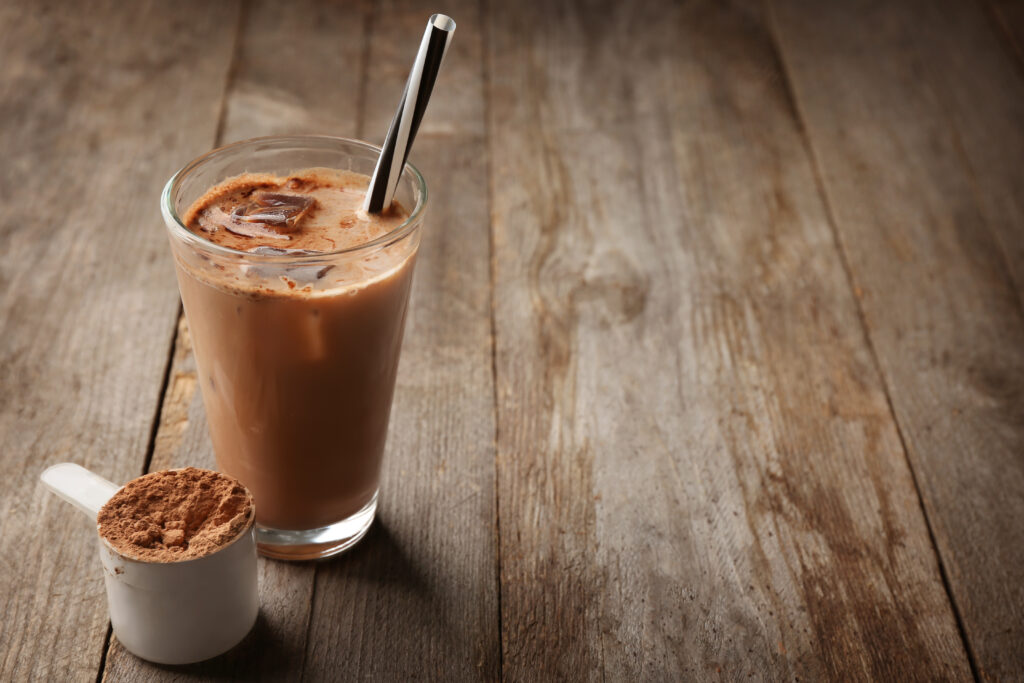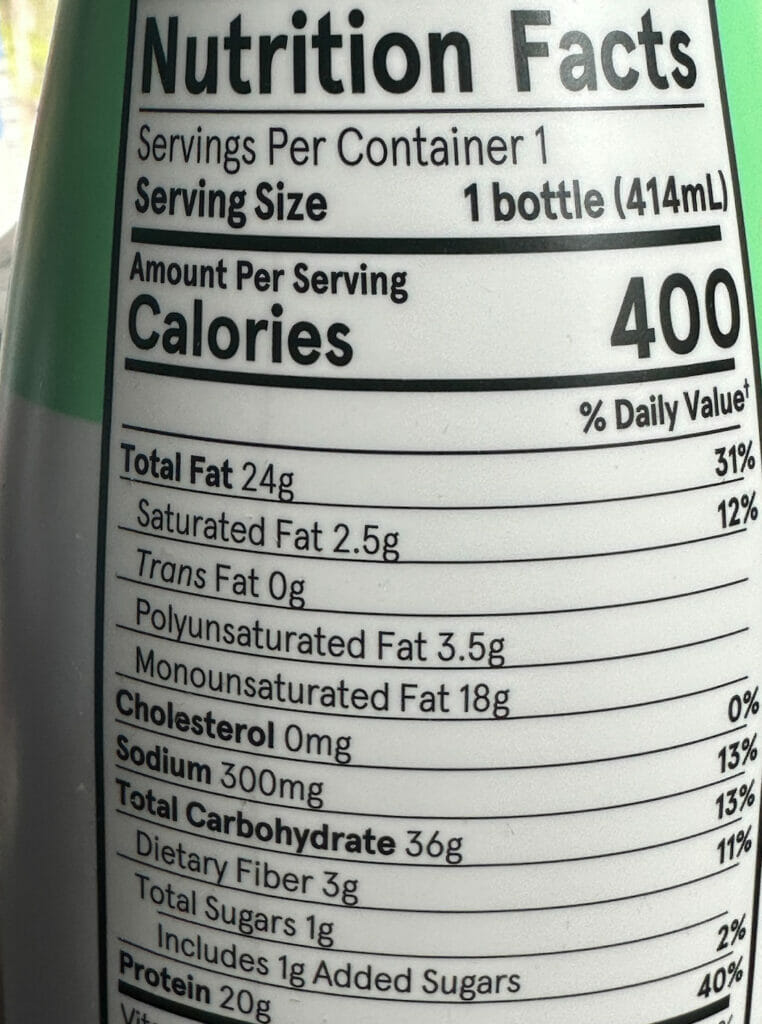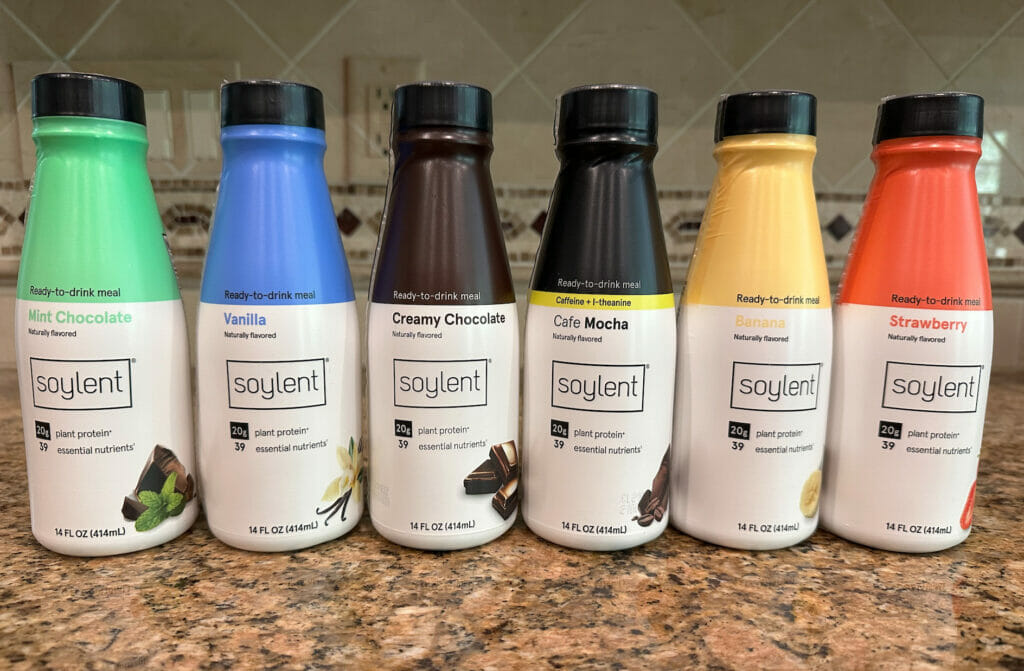![]()

Soylent offers a series of soy-based meal replacement shakes that are conveniently packaged up in individual bottles, making them super convenient for when you want a quick meal or don’t feel like pulling out the blender.
These shakes are completely plant based, so they’re vegan friendly, and they’re packed with a healthy collection of vitamins and minerals.
This is all fine and good, but let’s be real – there are a ton of vegan meal replacement shakes out there, so what (if anything) sets Soylent apart from the rest?
Well, besides the convenience of having them be pre-mixed, I’ll tell ya – taste.
Long story short, Soylent is one of the best tasting protein shakes I’ve ever tried – and I’m talking about any protein shake, not just plant based.
If you’re interested in the longer story, keep reading.
In this review, I’ll go over everything these Soylent shakes have to offer, as well as which flavors taste the best.
After reading, you’ll know whether or not these soy-based shakes are worth trying.
Disclaimer – the good folks at Soylent were kind enough to send me a variety pack to sample, but I wasn’t compensated in any other way. This review is based solely on my personal experience with this product. That said, as an affiliate, I will earn a commission if you purchase their product through a link on this article (but it doesn’t affect your cost).
Soylent Meal Replacement Shakes
You know, I gotta say, I think it takes guts to name your protein shake after a fictional food product made out of dead people.
Does anyone else remember that old sci-fi movie “Soylent Green”?
I saw it as a kid… I remember it being ok, it had Charlton Heston in it I think and he’s great.
It was about a futuristic world where over-population had created a shortage of natural resources, so this company starts creating food products that are supposed to made out of plankton, but it’s really made out of… wait for it… dead people.
“Soylent Green is people!”
Ha, I don’t know, maybe I’m dating myself here.
Either way, I think it’s a great name for a soy-based shake today and I’m pretty confident it isn’t made from humans.
Speaking of ingredients, that’s probably a good place to start, so let’s go over what this stuff is actually made out of.
Pros
- Great taste/texture
- Completely plant-based
- Vegan friendly
- Kosher
- Dairy/nut free
- Good serving of healthy fats
- Fairly low carb
- No artificial flavors
- Includes a serving of lots of different vitamins/minerals
- Contains all 9 essential amino acids
- Can be used as meal replacement
- Reasonably priced
Cons
- Could have more protein per shake
Ingredients
As I’m writing this, Soylent offers 6 different shake flavors and the ingredients might vary a little depending on which flavor you get, but they’re all vegan, Kosher, gluten-free, and nut-free.
Again, the ingredients will vary a little by flavor, but they main ingredients are pretty identical across the board.
I’m going to use the mint chocolate flavor as my guide here (because it’s my personal favorite) and they include:
- Filtered water
- Soy protein isolate
- Maltodextrin (thickener, preservative)
- High oleic sunflower oil
- Allulose (low calorie sugar)
- Canola oil
- Cocoa powder
- Natural flavors
- Vitamin & mineral mix
- Soluble corn fiber
- Soy lecithin (emulsifier, keeps shake from separating)
- Cellulose (fiber)
- Salt
- Gellan gum (thickening agent)
- Sucralose (calorie-free sugar, like Splenda)
Alright, I’m no nutritionist, so I’ll let you do your own homework reading any of these ingredients you don’t recognize, but I would like to point out a few things from the list above.
Unlike some plant-based protein shakes, all of the protein in Soylent comes from soy – I’ll go into a little more detail below, but there isn’t any pea or rice based protein in this stuff.
I’d also like to point out that there’s a fair amount of oil in these shakes.
You’ll notice that both sunflower and canola oil are listed above and the sunflower oil is pretty high up on the list (meaning there’s more of it in the shake).
Our first instinct might be to think of this as being a bad thing, but both of these oils are considered relatively healthy because they’re both high in monounsaturated fats, aka the “good fats”.
These oils give the shake a healthy dose of fat, which contain the omega-3’s which are beneficial for cardiovascular health (I believe they help reduce LDL’s).
I’m also thinking its these fats that help contribute to the overall creaminess of the shake, but I’m not sure.
There is some sugar in there, in the form of allulose, a sugar that’s found in figs, as well a sugar substitute (sucralose), but overall these shakes are very low in added sugars.
And there are also no artificial flavors, which is always a good thing.
Overall, I don’t have any problems with the ingredients used in Soylent.
Vitamin & Mineral Mix
The included vitamins and minerals in these shakes are pretty identical regardless of which flavor you go with and I don’t really feel like typing out each one.
To my defense, there are like 28 of ’em.
You can check out their site for the full list, but it’s basically all the major vitamin and minerals you’d expect to find in any multi-vitamin.
One shake contains 15 – 20% of your daily value for each one, which isn’t bad.
Nutritional Stats
Alright, we went over the ingredients, but let’s take a look at the actual nutritional stats these shakes are rockin’.
Soylent did a good job of making the nutritional stats for all their shakes pretty darn similar – you might see a few small variances from flavor to flavor, but all the main stuff is identical.
These include:

Yeah, sorry, I didn’t want to write all of that stuff either, so I hope you can see everything on the label there.
As I mentioned, there’s a pretty high amount of fat, but you’ll notice that 21.5 of the 24 g of fat is of the unsaturated variety.
I like that it’s cholesterol free and that there isn’t that much sodium either (especially considering this is suppose to replace a full meal).
With 36 g of total carbohydrates, I would consider these shakes to be pretty low-carb as well and 3 g of fiber isn’t bad for a shake.
And 20 g of protein isn’t bad for a meal replacement, but personally, I’d like to see a little more protein considering this is a 400 calorie shake.
Speaking of calories, 400 is a bit much for a standard protein shake, but keep in mind these Soylent shakes are meant to be used as meal replacements.
And if you do that, 400 calories is great – I know I have a hard time keeping any meal I eat to a mere 400 calories.
But again, I wouldn’t want to use Soylents as an after-workout protein shake or a snack because the calories are a bit higher for what I’m looking for in those circumstances.
Overall though, Soylent shakes are high in health fats, low in carbs, and offer a decent serving of plant-based protein.
I don’t know all the rules of these diets, but I would think these would work well for folks doing Atkins or any other high protein/fat and low carb diet.

Taste
Ok, we’ve gone over all the ingredients and nutritional stats, but it’s time to get to the important stuff – how these shakes actually taste.
Soylent sent me a variety pack, so I got to try all 6 of their flavors and even though I certainly liked some better than others, I want to congratulate Soylent on creating some great tasting shakes.
Regardless of flavor, these are some of the creamiest protein shakes I’ve ever tried.
And I’m gonna be completely honest – I don’t usually particularly like soy-based protein shakes – there’s just something about the soy flavor profile that I don’t quite get.
I think it started when my son was an infant and we had him on soy milk for a short bit (because of allergies) – I tried drinking that for awhile and I never got a taste for it.
Either way, I really like the texture and creaminess these shakes offer.
As I’m writing this, Soylent offers 6 different pre-mixed, ready to drink shake flavors. Here they are in order of my favorite to my least favorite:
- Mint Chocolate
- Vanilla
- Creamy Chocolate
- Cafe Mocha
- Banana
- Strawberry
Yeah, the mint chocolate is straight up delicious.
Imagine a milk shake made out of those Girl Scout Thin Mint cookies and that’s what it tastes like.
The Vanilla is also great and tastes a lot like what you’d expect a vanilla milk shake coming right out of the refrigerator would taste like.
I didn’t particularly care for the banana or strawberry flavors, but I’m not a big fan of banana in anything, so that doesn’t say much.
And the strawberry flavor just didn’t do much for me, almost reminded me of medicine, but not in a completely awful way.
What surprised me though, is how much I enjoyed the Cafe Mocha flavor because I’m not a coffee drinker.
It was pretty good for a coffee drink (and fyi, it contains 150 mg of caffeine too, or as much in about 1.5 cups of coffee).
So, overall, I think the Soylent shakes taste really good, but like any other meal replacement shake on the planet, they aren’t especially filling.
For me, they work best in the morning because I usually have a small breakfast or skip it all together, but I’d have a hard time only having one of these shakes for lunch.
The fat content helps make ’em a little more filling, but 400 calories is only gonna fill ya up so much.
But if you’re dieting, the cold reality is that if you’re doing it right, you’re gonna be hungry.
Cost
Before I wrap this review up, I want to talk about Soylent’s cost.
At the time of writing this, you can get 12 Soylent shakes for $48 (variety) or $45 (single flavor). You can also drop that cost down by $5-6 with an ongoing subscription.
But I’m talking about the variety pack here, so let’s use the $48 price.
At $48 for 12 shakes, that’s $4/shake.
That’s not bad if we’re considering these as individual meals because I know I’d spend a lot more than that if I went out for lunch.
But how does it compare to some of the other top vegan meal replacements?
Well, for the sake of comparison, LyfeFuel’s Daily Essential Shake goes for $2.92/meal and Ka’Chava goes for around $4.66/meal for a one-time purchase.
And both of those come in powder form, so they don’t have the same convenience factor that Soylent offers (and we all know getting your shake pre-made is going to cost a little more).
There’s also Huel, another plant based shake that’s already mixed and it’s going for just over $5/meal.
So, overall, I think Soylent is priced reasonably – it’s not the cheapest shake out there, but it isn’t the most expensive either.
Final Thoughts
Ok, I think that about does it.
I enjoyed sampling these protein shakes and I’d like to thank Soylent again for being kind enough to send me a variety pack for this review.
I could see these shakes being a great option for vegans or anybody else looking for a tasty plant-based meal replacement shake.
Soylent’s nutritional data is fine, but it’s their texture and flavor that really sets these shakes apart from any other plant-based protein shake I’ve ever tasted.
Of the 6 flavors I tried, I legitimately liked 3 of them (mint chocolate, vanilla, chocolate), was pleasantly surprised by 1 of them (cafe mocha), and didn’t care for 2 of them (banana, strawberry).
But man, that mint chocolate is no joke.
If you’re looking for an easy meal replacement shake, I encourage you to give Soylent a try.
Oh, and I didn’t get to try their other products, but they do also have straight up protein shakes, powders, and snack bars as well.
And lastly, you can also save 10% off any order using the promo code: HOMEGYM10.



